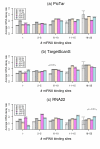Insight into microRNA regulation by analyzing the characteristics of their targets in humans
- PMID: 20003303
- PMCID: PMC2799441
- DOI: 10.1186/1471-2164-10-594
Insight into microRNA regulation by analyzing the characteristics of their targets in humans
Abstract
Background: microRNAs (miRNAs) are believed to regulate their targets through posttranscriptional gene regulation and have the potential to silence gene expression via multiple mechanisms. Despite previous advances on miRNA regulation of gene expression, little has been investigated from a genome scale.
Results: To gain new insight into miRNA regulation in humans, we used large scale data and carried out a series of studies to compare various features of miRNA target genes to that of non-miRNA target genes. We observed significant differences between miRNA and non-miRNA target genes for a number of characteristics, including higher and broader mRNA expression, faster mRNA decay rate, longer protein half-life, and longer gene structures. Based on these features and by analyzing their relationships we found that miRNA target genes, other than having miRNA repression, were most likely under more complex regulation than non-miRNA target genes, which was evidenced by their higher and broader gene expression but longer gene structures. Our results of higher and broader gene expression but fast mRNA decay rates also provide evidence that miRNA dampening of the output of preexisting transcripts facilitates a more rapid and robust transition to new expression programs. This could be achieved by enhancing mRNA degradation through an additive effect from multiple miRNA targeting.
Conclusion: Genome-scale analysis on the nature of miRNA target genes has revealed a general mechanism for miRNA regulation of human gene expression. The results of this study also indicate that miRNA target genes, other than having miRNA repression, are under more complex gene regulation than non-miRNA target genes. These findings provide novel insight into miRNA regulation of human gene expression.
Figures







Similar articles
-
The Emerging Role of MitomiRs in the Pathophysiology of Human Disease.Adv Exp Med Biol. 2015;888:123-54. doi: 10.1007/978-3-319-22671-2_8. Adv Exp Med Biol. 2015. PMID: 26663182
-
The roles of binding site arrangement and combinatorial targeting in microRNA repression of gene expression.Genome Biol. 2007;8(8):R166. doi: 10.1186/gb-2007-8-8-r166. Genome Biol. 2007. PMID: 17697356 Free PMC article.
-
Concordant regulation of translation and mRNA abundance for hundreds of targets of a human microRNA.PLoS Biol. 2009 Nov;7(11):e1000238. doi: 10.1371/journal.pbio.1000238. Epub 2009 Nov 10. PLoS Biol. 2009. PMID: 19901979 Free PMC article.
-
MicroRNAs silence gene expression by repressing protein expression and/or by promoting mRNA decay.Cold Spring Harb Symp Quant Biol. 2006;71:523-30. doi: 10.1101/sqb.2006.71.013. Cold Spring Harb Symp Quant Biol. 2006. PMID: 17381335 Review.
-
Mechanisms of microRNA-mediated gene regulation.Sci China C Life Sci. 2009 Dec;52(12):1111-6. doi: 10.1007/s11427-009-0152-y. Epub 2009 Dec 17. Sci China C Life Sci. 2009. PMID: 20016967 Review.
Cited by
-
Therapeutic implications of microRNAs in pulmonary arterial hypertension.BMB Rep. 2014 Jun;47(6):311-7. doi: 10.5483/bmbrep.2014.47.6.085. BMB Rep. 2014. PMID: 24755557 Free PMC article. Review.
-
Transcriptional regulation of co-expressed microRNA target genes.Genomics. 2011 Dec;98(6):445-52. doi: 10.1016/j.ygeno.2011.09.004. Epub 2011 Oct 2. Genomics. 2011. PMID: 22002038 Free PMC article.
-
MicroRNAs as tools to predict glucocorticoid response in inflammatory bowel diseases.World J Gastroenterol. 2013 Nov 28;19(44):7947-54. doi: 10.3748/wjg.v19.i44.7947. World J Gastroenterol. 2013. PMID: 24307788 Free PMC article. Review.
-
Plasma exosomes from children with juvenile dermatomyositis are taken up by human aortic endothelial cells and are associated with altered gene expression in those cells.Pediatr Rheumatol Online J. 2019 Jul 12;17(1):41. doi: 10.1186/s12969-019-0347-0. Pediatr Rheumatol Online J. 2019. PMID: 31299993 Free PMC article.
-
Computational methods for the identification of microRNA targets.Open Access Bioinformatics. 2010 May 1;2:29-39. doi: 10.2147/OAB.S6902. Open Access Bioinformatics. 2010. PMID: 22162940 Free PMC article.
References
Publication types
MeSH terms
Substances
Grants and funding
LinkOut - more resources
Full Text Sources

